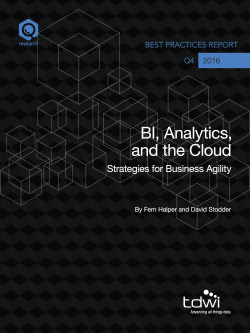
Best Practices Report | BI, Analytics, and the Cloud: Strategies for Business Agility
October 3, 2016
The cloud is becoming a mature platform for data management, integration, business intelligence (BI), and analytics. Although some organizations still will not make use of it (typically for security or compliance reasons), resistance is definitely diminishing. Companies understand that the cloud can provide flexibility and scalability for their BI and analytics projects. Of course, the cloud is not yet for every company, but organizations like the fact that it allows them to be more agile—they can quickly spin up (or down) instances of the cloud for BI and analytics and they like that.
We’ve found that organizations are making use of the cloud in numerous ways. Some are using it to expand the number of users who can perform visual analytics and discovery and to provide more sophisticated tools than spreadsheets. Others are using the cloud to help modernize their data warehouse for analytics. Still others are using it to experiment with analytics outside of the data warehouse, which often includes experimenting with open source technologies. They are also using the cloud for part of their more advanced analytics implementations, such as for big data analytics.
As expected, security still tops the list of barriers cited by respondents in this study by a margin of almost 2-to-1. Some organizations realize that security concerns are often really more about perceived security issues or, more likely, about losing control over data. This is often a political or cultural issue. Privacy also ranks high on the list of challenges associated with the cloud, along with security, isolation of a company’s assets from those of others, identity management, and integration between on-premises data with their public or private cloud. These are all big considerations for organizations looking to move BI and analytics to the cloud. Integration of data residing on premises and off premises is an important aspect of cloud analytics because the majority of respondents in this study think that they will ultimately move to a hybrid architecture, where public and private cloud
platforms are used along with on-premises systems. To do this effectively, they will need to deal with integrating data in an evolving ecosystem that includes the cloud and on-premises data warehouses or other data management environments.
Overall, it appears that respondents are more satisfied than not with cloud BI and analytics across many categories of variables. This includes their ability to load data from on-premises systems to cloud-based systems and perform data transformations there. However, there is significant room
for improvement. One concern is the time it takes to perform these procedures. Additionally,although organizations are also reasonably satisfied with data integration, they face mounting challenges as data becomes more complex and users demand faster data refreshes. Cloud governance is also an issue.
This TDWI Best Practices Report examines organizations’ experiences with and plans for cloud BI and analytics, including how satisfied organizations are with the cloud and why. It also looks at various challenges and how organizations are overcoming them, as well as some new cloud models. Finally, it looks at what organizations should consider when moving to the cloud.